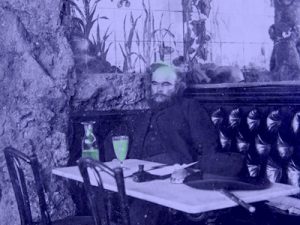
Pelham Grenville Wodehouse, the British author of cultishly-popular humorous novels, short stories and plays (Jeeves and Bertie Wooster are probably his most famous fictional creations, and he worked on musicals with composers like George Gershwin and Jerome Kern) became unexpectedly controversial at the height of his popularity.
He was residing in France in 1940 when the Nazis over-ran the country. As a British citizen, he was interred as an enemy alien. The Nazis knew they had a prize catch, however, for Wodehouse was famous throughout the world, and they were anxious to use him for propaganda purposes. They transferred him to a prison in Berlin and made him an offer: he would be treated decently if he would just make a few pro-German radio broadcasts. He agreed to do so — to save his skin, he would later say — he would also claim that they were harmless broadcasts in which he simply joked about his imprisonment.
But he didn’t anticipate the repercussions. After the war, the good-natured comic author was branded as a traitor and collaborator by most Britons. He was never actually tried for treason, but in effect he was “drummed out” of his native land.
He came to the U.S., eventually settling in Remsenburg, Long Island, where he resumed his interrupted literary output. He became a U.S. citizen in 1956 and was eventually forgiven and even knighted by Queen Elizabeth in 1975. He died in 1975 at the age of 94 and was buried in Remsenburg.
Why this history lesson? Well, my daughter and I were recently visiting the Hamptons, near Remsenburg, and decided we had to take time out to pay a respectful pilgrimage to P.G.’s gravesite.
Easier said than done. If you research it on the internet, you will learn that Wodehouse is buried in the “Historic Remsenburg Cemetery”, and you will even find a photograph of his gravestone. Remsenburg is a small (but very affluent) town near the Hamptons — we figured it would be a cinch to find the gravesite.
Three of us set out to do so — me, my wife and our daughter — one day this past July. Arriving in Remsenburg, we drove around the largely residential community for a short time, hoping to get lucky. We sighted no cemeteries and finally decided to ask directions at the Remsenburg Post Office. An elderly woman was just leaving the Post Office, carrying her mail — obviously a local resident — so we asked her for help (remember, Wodehouse was Remsenburg’s most famous resident for many years). She said, oh, sure, he’s buried in the “historic cemetery” and we could walk there from the Post Office. She gave us directions, we thanked her profusely and walked off, relieved that our quest would be over so easily.
In a few minutes we arrived at the cemetery, and, believe me, it was “historic”. First of all, it was tiny, about the size of my living room/dining room area. And second, every stone there looked like it was from the Revolutionary War era. With one glance, it was obvious that P.G.’s gravestone was not going to be found there.
Dejected, we searched around the immediate area carefully, walking a few blocks in each direction to make sure we weren’t missing anything. Then, back to the Post Office.
This time we went inside and spoke to the clerk (no other customers were around). She called her boss in from the back for additional help. They both agreed that Wodehouse HAD to be in the “historic cemetery”. We assured them that he was not there and wondered if there were other cemeteries in the area. They couldn’t think of any, but referred us to a community center across the street, where people might be able to help us. After more thank you’s, we went across the street where we were lucky enough to find five people of various ages who were planning an upcoming social event. After we explained our quest to them, they went through the “historic cemetery” routine with us. When we explained that we just came from there, they began to seriously try to locate other cemeteries in town, using ancient wall maps that were hanging in the room.
Gathering all the info we could from the maps, and with many thanks, we continued on our way. To make a long story just a little shorter, in the end we couldn’t locate any of the cemeteries that were indicated on those old wall maps — don’t know what happened to them, but they simply weren’t where they were supposed to be.
By this time, we were getting antsy — who needs this aggravation, it’s only a gravesite! But a quest is a quest.
What we decided to do was drive out of town slowly, keeping a sharp lookout for anything that might hide a cemetery. We were at the point of giving up in defeat, when we passed a church building we hadn’t seen before, the Remsenburg Community Church. With hope all but gone, we walked behind the building and saw gravestones! Not just a few, but many, and lots of new ones, at that. The graveyard extended in a thin line behind the church and went back a long way. What the heck, we all agreed, let’s give it a try. Slowly we made our way back, checking stone after stone. Toward the rear of the grounds, there it was — P.G.’s gravestone.
We spent about fifteen minutes at the site (big photo opportunity) and then happily returned to our car, our Wodehouse pilgrimage successfully completed.





10 Responses
Enjoyed this!Some interesting
Enjoyed this!
Some interesting history topped off with an exciting modern-day search/adventure. Nice report.
I was caught up in the suspense of wondering if you would find the grave. Glad you did!
It’s hard to know what one would do if captured by an enemy and ordered to say things on film. One likes to believe they would blink their eyes in Morse code, like Jeremiah Denton did when he was a prisoner of war in Viet Nam, spelling out “torture” when he was made to speak on camera – but damn it, I don’t even know Morse code.
more about wodehouseThanks,
more about wodehouse
Thanks, Eli. One reason I find this story amusing is that everybody was sure he was buried in the Historical Cemetery.
I’ve written a bunch about P. G. Wodehouse on LitKicks … it’s my personal theory that his stuff can be read as more subversive and multi-layered than is commonly thought. I really dislike the whole “Ask Jeeves” trivialization of Wodehouse’s sharp sense of humor. It’s similar to the cliche that Sherlock Holmes has become — Holmes is another character written with a lot more depth than his eventual cartoon image would show.
My favorite twist on the Jeeves mystique is the film Remains of the Day. Which would lead into another question: if this is Bertie Wooster’s grave, where would Jeeves be found?
Beech from Wodehouse’s
Beech from Wodehouse’s Blandings Castle is actually a better butler than Jeeves, I think. He drinks, gambles, doesn’t like aristocrats; he only rescues Lord Emsworth from scrapes because that’s his job.
Am a fan of Wodehouse. How
Am a fan of Wodehouse. How can these rather silly people in the town he’s buried in be so misdirected? Wodehouse is probably their most, or one of their most, famous “residents”…Interesting piece…
Thanks for this – My entire
Thanks for this – My entire family (well almost) loves Plum’s work! I recently moved to Long Island and my dad is coming to visit. We thank you for doing the ground work and writing about it as it will make our pilgrimage easier
I’m looking for the specific Wodehouse Blandings novel/short story that contains a reference to the cocktail “Death Comes For The Archbishop.” I ran across a reference to this cocktail in the BBC series Blandings Season One, Episode Six. It’s my view that Wodehouse wrote nothing by accident. “Death Comes For The Archbishop,’ of course is a Willa Cather novel. It’s considered one of her best works. But Wodehouse, a contemporary of Cather, must have had some reason for naming this rather extreme cocktail after this novel. The cocktail consists of “Gin, Brandy, Sherry, Port, Pudding Wine and a liberal amount of bitters.” No measures were included.
What all this tells me is that Wodehouse read Cather. Was he poking fun of her and this novel by naming a cocktail after “Death Comes For the Archbishop?” Cather was a copious letter writer. I wonder if there was any correspondence between them? I’ll research. The Willa Cather Foundation has most of Cather’s extant correspondence. The British Library has the papers and correspondance of Wodehouse.
Interesting question, Ronald Lapp – I’d like to know the answer myself. I think Willa Cather was a popular writer of this time, so I’m guessing Wodehouse was simply having fun with a trendy book title, and I bet it was meant as an affectionate poking of fun.
You mention that you saw this reference in a BBC series, so I’m also curious if it can be found in a Wodehouse text. If not, it may have been added by a scriptwriter. For what it’s worth, I don’t think any television series has ever successfully captured the PG Wodehouse magic.
Thank you for your comments Marc Eliot Stein. I agree that Wodehouse was having fun with Cather’s book title. I will now try tracking down the reference to the “Archbishop” cocktail in Wodehouse’s Blandings works.
I also agree that the Blandings TV series doesn’t completely capture the Wodehouse magic, but it does try very hard, maybe too hard. 😉 On the other hand, I doubt that a British screenwriter would have added such an esoteric reference on their own. Maybe. Hmmm.
A side note about Cather. While Cather was indeed a popular writer of her time, she remains so in interesting ways. The Willa Cather Foundation out of Red Cloud, Nebraska, is the most funded foundation of any American author. Indeed, the whole of Red Cloud has become a museum/archive to her work and life and times. There is both a yearly Spring Conference and an International Conference set in different Cather spots around the country and sometimes in Europe that are devoted to Cather and her work. Both conferences are inexpensive to attend because the Foundation can ably subsidize them. An additional purpose of the Foundation is to keep Cather’s work popular in schools and universities and much of their money goes to that end. Indeed, I teach Cather’s O Pioneers to advanced ESL students (mostly immigrants) because of its focus on immigrants to the American prairie and the parallels with my students’ new-to-the-U.S. experiences.
Thank you for doing the legwork. I am planning to visit the cemetery in Remsenburg in June. I would have come back without visiting the grave because I lack the tenacity though I must say my love and admiration for Plum is no less than the next person. Plum is very popular in India and many wonder why!!
Hello, and thank you for the interesting article. Hope to go there one day! I haven’t heard or read the WWII broadcasts but have read about them in several biographies and Wodehouse himself discussing the period. As I understand it, they were in no sense “pro-German” broadcasts, but rather lighthearted stories designed to amuse the other British prisoners in Wodehouse’s situation. (See https://www.timesofisrael.com/author-p-g-wodehouses-apologia-of-nazi-germany-broadcasts-revealed/: “Wodehouse never expressed any support or sympathy for the Nazi cause.”) He later deeply regretted them because he recognized it was inappropriate and terribly naive to produce something light in the midst of such suffering, but from what I’ve seen, it does not seem accurate to say he wrote anything pro-German during the war.